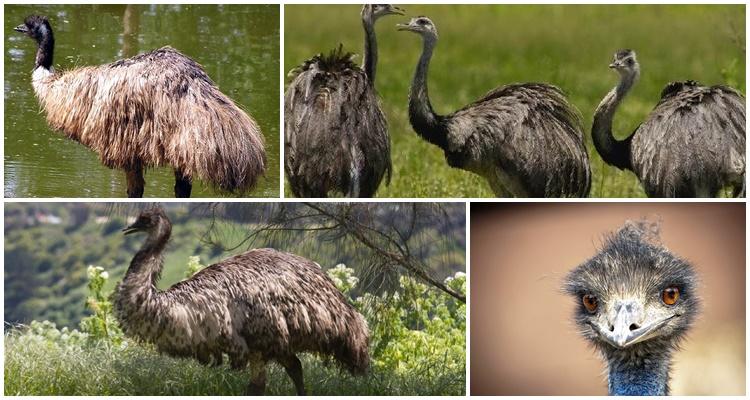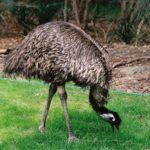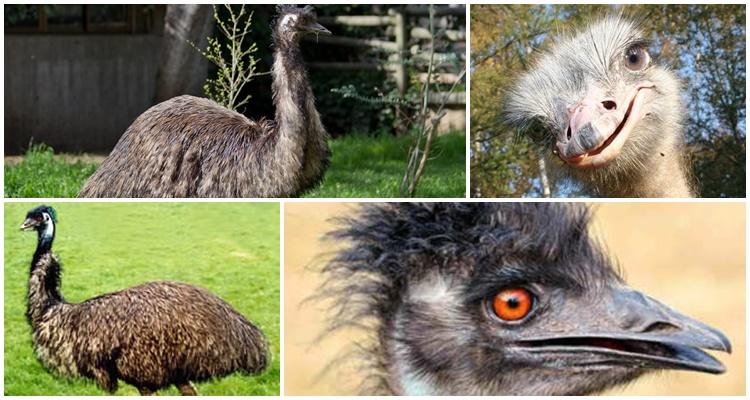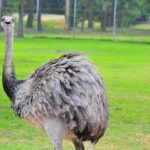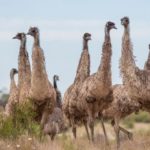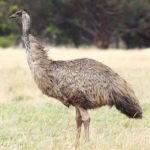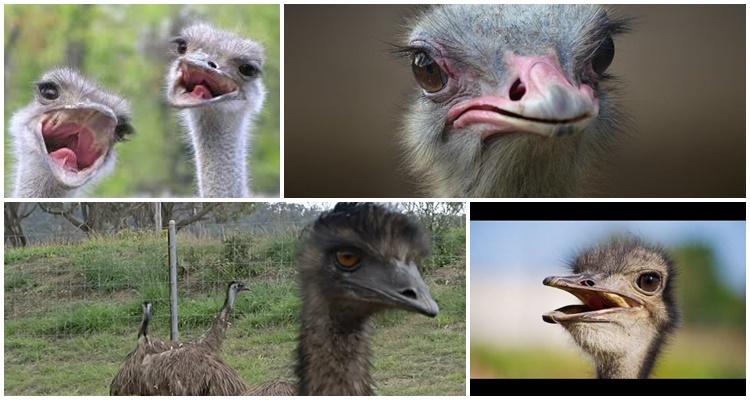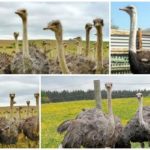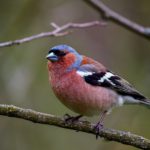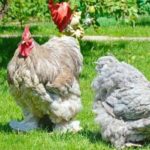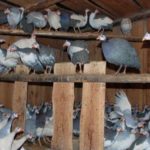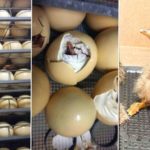Emu ostriches are similar in appearance to real African ostriches, but according to biological classification they do not belong to them. Let's consider the description and characteristics of this bird species, how it differs from the African ostrich, productive characteristics. How to properly keep, care for and feed emus at home. How to raise birds at home.
Origin story
Australia, home of the emu, has been a closed continent for millions of years and is home to many endemic species.At first, emus were classified as ostriches, but later it turned out that they have many differences, and emus are more similar to cassowaries. In the modern classification, the species is conventionally divided into 3 subspecies, which have external differences and live in different regions of the continent.
Description and characteristics of emu
In appearance, the emu resembles a cassowary, but it does not have leathery outgrowths on its neck. The plumage is dark brown. Body length – 1.5-1.9 m, weight – 30-55 kg. Running speed is 50 km/h, step width is 2.5 m. In nature, birds are able to travel long distances in search of food. They drink once a day, more if the opportunity arises, they even know how to swim.
Externally, it is difficult to distinguish females from males - there are no special differences in size and color of plumage. The difference can be noticed during the mating season - males, when calling females, make guttural sounds. The birds are calm in nature and can only be aggressive during the breeding season. They treat people calmly, and they also react adequately to their fellow humans.
Differences from ostrich
The Australian emu is smaller than the African ostrich. It also has differences in the structure of its bones: there are 3 toes on its feet, not 2, and there are claws on each toe. There are also growths similar to claws on underdeveloped wings. Females and males are almost identical in size and plumage; they can be distinguished by the sounds they make. The emu differs from the ostrich in that it lives alone or in small families of 3-5 birds.
Where does he live?
Emus have settled throughout Australia and on the island of Tasmania.They live in savannas and bushes, but are not found in deserts.
Productivity
Outside the Australian continent, emu is grown in North America, Peru and China and other countries, although to a lesser extent. Birds are primarily raised for their meat, eggs, skin and fat. The meat is lean, high in protein and low in cholesterol. It is red in color and looks and tastes like beef. Lenten and refers to dietary products. It can be used by people of any age, healthy and sick, and overweight people. Slaughter yield is on average 55%.
Each female can lay up to 50 eggs. Each can replace 10-15 pieces of chicken at once. Ostrich eggs can be boiled, fried, or made into an omelet. The durable shell is used for crafts. Healthy female emus can lay eggs for a maximum of 20 years. Fat is used to prepare medicinal and cosmetic products. Leather - for making bags, shoes, clothes, wallets. Products made from ostrich leather are valued for their beauty, original texture, strength, durability, and moisture resistance. Feathers - for decorating dresses and hats.
Features of maintenance and care
Emas tolerate cold well, but they cannot be kept outside all the time. For them you need to build a warm, closed room, the temperature in which will not be lower than 15 ° C. In summer, you can keep ostriches in an open range around the clock, but you need to build a covered shed in it, where the birds can hide in the rain and wind. In winter, you can also release birds there, but only if the frost does not exceed -15 ˚С and there is no wind.
Each adult emu will require 10-15 square meters. m of poultry house area, for a baby ostrich – 5 sq. m. The corral should be even larger - 50 sq. m. m. per bird.
The grazing area should be fenced with a high fence 2 m high to prevent birds from sneaking out. A fine mesh is used for it, this is necessary so that ostriches cannot stick their heads into the holes and get injured. All sharp edges need to be rounded for the same reason.
Caring for Australian emus consists of cleaning the room and changing the bedding, which needs to be changed at least once a week. Ventilate the room every day by opening windows and doors. But it is better to install an automatic ventilation system that will maintain the level of air purity without human intervention.
Emu ostriches are endowed with strong immunity and rarely get sick if they are raised properly. But still, these large birds can also become ill with respiratory viral and bacterial diseases. With poor nutrition, they suffer from digestive disorders, poisoning, gastrointestinal diseases, acute and chronic. The lush feathers of ostriches can harbor parasites.
Keeping ostriches involves carrying out preventive treatment of the livestock against external and internal parasites, vaccination against viral diseases. And treatment if the disease has already developed. If a chick or an adult ostrich gets sick, it should be placed in a separate room so that it does not come into contact with healthy pets. Treat the rest by giving them a prophylactic dose of the drug. You can return the ostrich back only after full restoration of health.
Diet planning
Of course, feeding emus what they eat in their homeland will not work. Birds reared in artificial conditions have adapted to the local vegetation and eat grass, for example, clover and alfalfa, as well as tops of garden plants, greens, and forbs.In the summer, ostriches can even be grazed on ordinary pastures, and hay and silage can be stored for the winter.
Emu will not refuse fruits, berries, and vegetables. In addition, the diet should contain grain mixtures with the addition of premixes, bone meal, chalk and salt. Each ostrich is given 3 kg of feed per day, and half of this amount should be taken up by roughage and succulent feed.
You can replace mash with poultry feed. Of course, you will need a lot of it, but using ready-made mixtures is beneficial - they are stored for a long time, do not spoil, and do not take up much space. But the most important thing is that birds grow faster on this diet than on grass-grain mixtures. When industrially growing emu, it is recommended to choose this option.
To prevent birds from feeling thirsty, they need to be watered 3 times a day. The drinking bowls must have fresh water, so it needs to be changed every day. Like other birds, emus need small pebbles, which must enter the stomach to grind food. Therefore, you need to place a vessel in the poultry house and pour fine gravel into it.
Breeding rules
The breeding season for emus is December-January; with artificial breeding, it is in the spring. An ostrich family consists of 1 male and 1-2 females. One female lays up to 10 eggs with green shells weighing 0.7-0.9 kg each. The male incubates the eggs for 50-60 days. He sits in the nest almost 24 hours a day, but leaves for a while to eat. During incubation, ostrich eggs turn from green to blue-green. This means that the chicks develop successfully in them.
The chicks hatch weighing 0.5 kg. They grow quickly, sexual maturity occurs at 2 years. When breeding in an incubator, which is used on ostrich farms, in order not to keep many males, the temperature is maintained at 37-38 ° C and humidity at 40-70%.
After hatching, the chicks are sent to a room separate from the adult birds. There they are kept until 3-4 months of age at a temperature of 20˚C. Then they are released for general grazing. In the first days, ostrich chicks, like chickens, are fed a mixture of boiled eggs, cottage cheese and greens. Then the young animals are transferred to light feed intended for chickens. By the age of one month, ostrich chicks can be accustomed to grain mash, greens, vegetables and fruits.
You can also feed them on mixed feed if such feeding is profitable. The advantages of compound feed are the rapid growth of chicks and adult birds, ease of use. Disadvantages - high cost. The Australian emu can be a good investment. If you need to choose where you can make a profit, then you need to pay attention to the breeding of this bird, which is still exotic for agriculture.

